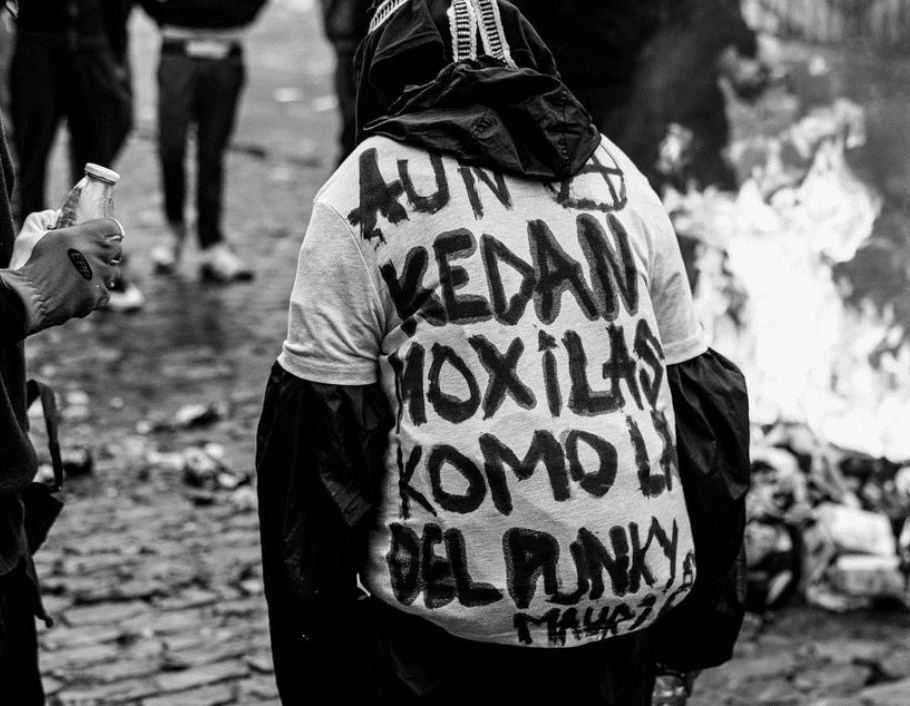
From Informativo Anarquista, a counter-information project, we write these words 15 years after the death in action of comrade Mauricio Morales, Punki Mauri.
*
Death is an event that inevitably takes us away from the body of the person who has passed away. But as quickly as the body withers, the common imagination turns to the dawn and unfolds the culminating fact of death towards hundreds, if not thousands, of memories, testimonies and actions that forge in the skin a vitality capable of driving a heart that beats in all directions.
Memory is not an exercise in unanimity or homogeneous plenitude. It does not always have the same points of reference or the same explanations. What it is, however, is collective, at the same time as it integrates shades and particularities that respond to their own places, to solitary or loose voices, which converge and meet on certain occasions between one and the other. In this sense, anarchic memory has been a point of connection, a motive for encounter that gives way to the search for and rapprochement of affinities with the decisions and paths that a companion built in life.
Mauricio Morales reflects, in part, what we want to say; how the heart of a dead comrade can be pumped with insistence. That, despite the pain and sadness, the persecutions and imprisonments that this brought, networks were built, complicities were strengthened and his anarchic memory continues to this day. We agree with the now extinct counter-information project Liberación Total (2011), that ‘death is an unbeatable obstacle, but in contrast, forgetting and passivity are walls that we know how to break down. Not only in relation to the comrade Mauri but to every insurrectionary spirit that has to live through the hardest circumstances of the paths we choose in life’.
In the exercise of their memory, the counter-information pages crossed communicational frontiers and provided an effective means of dissemination through which comrades from all over the world learned of Mauri’s death. The publication in them of words written by squatted social centres, friends, publishers, prisoners, action groups and Mauri himself, made possible the translation into different languages and the externalisation of an offensive memory to an international affinity.
Consulting a legend of black internationalism in the book Mapping the Fire (2012), one reads, no more and no less, that the pages of counter-information ‘are the messengers of our decision to get off the train of commitments and start a global journey of anarchy without a return ticket’.
The propagation of Mauricio Morales’ ideas, thoughts and contradictions was and is precisely the sign of a passage without a return ticket, especially because the comrade declared that the ideas coming out of our mouths were not enough, but the ones prevailing in active hands. Thus, the Italian counter-informative project Culmine understands that ‘(…) the affinity that we feel with Mauri is not only limited to the nihilistic aesthetics of his thoughts, no! We know that we have in front of us a comrade in action, one who has always confronted power to its ultimate consequences’.
Contagious of this spirit, in 2009, in a vindication of the explosive attack against the Chilean consulate in Greece, Conspiracy of Cells of Fire wrote that there are ‘people we have never met, but we know that we always look at things from the same perspective’. And a year later, also in reference to the Mauri, Marco Camenisch* expressed from a prison in Switzerland that ‘every death of ours, every failure of ours becomes a victory in the “strategic field” of the offensive’.
As a striking element of the black memory, we deny the rise of martyrs, heroes or untouchable figures, connecting with our dead comrades as a living whole that navigates agitated waters.
15 years after the attempt to attack the nest of jailers; the wall paintings, books, activities, counter-information projects, burning tyres, bottles flying in the wind, whistling bullets, incendiary or explosive planning, continue to carry the name of Punki Mauri through the streets, across languages, kilometres and generations.
Nothing is over, everything continuous.
A death in action is an eternal call to fight.
Together we can continue to keepo ensuring that anarchy lives on
Informativo Anarquista (Anarquist news)
May 2024
DN Note

*Marco Cameneisch is a Swiss eco anarchist in the late 1970s, who was involved in local opposition to the nuclear power industry. In Switzerland, as in other countries, the movement against nuclear power plants utilized tactics of direct action: cutting down electrical pylons, sabotage against power stations, and actions against leaders of the nuclear industry.
On Christmas eve of 1979, Camenisch with René Moser was accused sabotaging a power station belonging to NOK (Nordostschweizer Kraftwerke) at Bad Ragaz, St. Gallen with explosives, destroying two transformers and a power pole. The pair were arrested for the sabotage in January 1980 and after spending a year free on bail, the court of Canton in Chur and Graubünden sentenced Camenisch to 10 years in prison.
In December 1981, he escaped from Regensdorf prison near Zürich, along with 5 other prisoners. During the melée a prison guard was shot and killed, and another was seriously injured. Camenisch claimed he hadn’t been part of the group which committed the shootings. After the escape he spent 10 years in hiding.
In 1989, Swiss federal police and media claimed he was responsible for the killing of Swiss border police officer Kurt Moser at Brusio.
On November 5, 1991, Camenisch was stopped by Carabinieri on Cinquale di Montignoso road, along with fellow anarchist Giancarlo Sergianpietri. Camenisch produced a handgun and opened fire, wounding one of the soldiers. In the ensuing shootout, he was wounded in one leg and arrested. Two guns and six rudimentary bombs were found at his place. He was taken to Pisa hospital, where he remained for six months, and later at San Vittore prison infirmary in Milan. The Italian Court of Massa Carrara sentenced him to 12 years for assault and sabotage of electrical pylons. He served 9 of those years while in solitary confinement in a maximum-security prison.
In April 2002, Camenisch was extradited to Switzerland and transferred to a prison in Pfäffikon near Zürich. In January 2003, after a hunger strike against the conditions of imprisonment he was suffering, he was transferred to a prison in Chur with better conditions. In 2002 the Swiss government transferred him back to Pfäffikon. In July 2004 he was sentenced to seventeen years in prison for the killing of Kurt Moser.
In November 2006 the Federal Supreme Court nullified this sentence on the basis that the sum of the two prison terms would exceed the maximum of twenty years set by Swiss law. On 13 March the sentence was therefore reduced to eight years. Camenisch has never denounced the actions attrinuted to him or anarchism during his time in prison, and he remained constant communication with the anarchist circles outside. He was freed from prison on 10 March 2017, after 26 years.
(Chile) Mauricio Morales en el mapa de la ofensiva anarquista internacional
*
La muerte es un acontecimiento que nos aleja inevitablemente del cuerpo de quien ha dejado de vivir. Pero tan rápido como el cuerpo se marchita, el imaginario común gira a la aurora y despliega el hecho culmine de la muerte hacia cientos, sino miles, de recuerdos, testimonios y acciones que forjan en la piel una vitalidad capaz de impulsar un corazón que late en todas direcciones.
La memoria no es un ejercicio de unanimidad ni de plenitud homogénea. No siempre tiene los mismos puntos de referencia ni las mismas explicaciones. Lo que sí, es colectiva, a la vez que integra matices y particularidades que responden a lugares propios, a voces solitarias o sueltas, que convergen y se encuentran en determinadas ocasiones entre unas y otras. En tal sentido, la memoria anárquica ha sido un punto de conexión, un motivo de encuentro que da paso a la búsqueda y al acercamiento de afinidades con las decisiones y caminos que unx compañerx construyó en vida.
Mauricio Morales refleja, en parte, lo que queremos decir; de cómo, se llega a bombear con insistencia el corazón de un compañero que partió. Que, a pesar del dolor y las tristezas, de las persecuciones y encarcelamientos que eso acarreó, se tejieron redes, fortalecieron complicidades y se continuó con su memoria anárquica hasta el día de hoy. Coincidimos con el extinto proyecto de contrainformación Liberación Total (2011), que “la muerte es un obstáculo insuperable, pero a diferencia, el olvido y la pasividad son muros que sabemos romper. No solo en relación con el compañero Mauri sino con todo espíritu insurrecto que tiene que vivir las circunstancias más duras de los caminos que elegimos en la vida”.
En el ejercicio de su memoria las páginas de contrainformación atravesaron fronteras comunicacionales y aportaron con un eficaz motor de difusión por el cual compañerxs de todo el mundo supieron de la muerte del Mauri. La publicación en ellas de palabras escritas por centros sociales okupados, amistades, editoriales, presxs, grupos de acción y el mismo Mauri, posibilitaron la traducción a distintos idiomas y la exteriorización a una afinidad internacional de una memoria en ofensiva.
Consultando una leyenda del internacionalismo negro en el libro Mapeando el Fuego (2012), se lee, ni más ni menos, que las páginas de contrainformación “son los mensajeros de nuestra decisión sobre bajarnos del tren de los compromisos y empezar un viaje mundial de la anarquía sin un pasaje de vuelta”.
La difusión de las ideas, pensamientos y contradicciones de Mauricio Morales fue y es precisamente la señal de un pasaje sin vuelta, sobre todo porque el compañero declaró que no bastaban las ideas salidas de nuestras bocas, sino las que prevalecían en las manos activas. Es así, que el proyecto contrainformativo italiano Culmine comprende que “(…) la afinidad que probamos hacia Mauri no se limita solo a la estética nihilista de unos pensamientos suyos, ¡no! Sabemos que tenemos frente a nosotrxs un compañero de acción, uno que siempre se enfrentó con el poder hasta sus últimas consecuencias.”
Contagiados de ese espíritu, el mismo año 2009, en una reivindicación del atentado explosivo contra el consulado de Chile en Grecia, Conspiración de Células del Fuego escribió que hay “gente a la cual nunca hemos encontrado, pero sabemos que siempre miramos las cosas de la misma perspectiva”. Y un año después, también en referencia al Mauri, Marco Camenish expresó desde una prisión en Suiza que “cada muerte nuestra, cada fracaso nuestro llega a ser una victoria en el ‘campo estratégico’ de la ofensiva”.
Como elemento descollante de la memoria negra, negamos del levantamiento de mártires, héroes o figuras intocables, conectando con nuestrxs compañerxs muertxs como un conjunto vivaz que navega aguas inquietas.
A 15 años del intento por atacar el nido de carceleros; los murales, libros, actividades, proyectos contrainformativos, neumáticos en llamas, botellas surcando el viento, las balas silbando, planificaciones incendiarias o explosivas, siguen llevando el nombre del Punki Mauri a las calles, atravesando idiomas, kilómetros y generaciones.
Nada ha acabado, todo continúa
Una muerte en acción es un llamado eterno a luchar
Entre todxs podemos seguir procurando que viva la anarquía
Informativo Anarquista
Mayo 2024
Source: Informativo Anarquista